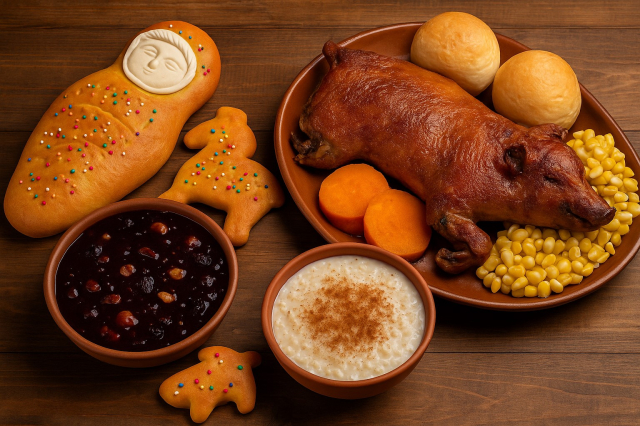The taste of tradition on All Saints' Day
Every November 1st, Peruvian families celebrate All Saints' Day , a day that unites faith and tradition, and, as with many of the country's festivities, food takes center stage. From the coast to the mountains and jungle, traditional dishes filled with history, aroma, and symbolism are prepared, shared with family or taken to the cemetery to honor the deceased.
This date, which precedes All Souls' Day (November 2), combines the solemnity of remembrance with the joy of family reunion. In each region of Peru, the flavors vary, but the meaning is the same: to fondly remember those who have passed away .
(Image suggestion 1: traditional Peruvian table with mazamorra morada, rice pudding and tanta wawa bread)
Alternative text: Table with typical dishes for All Saints' Day in Peru
Purple porridge and rice pudding: Peru's sweetest duo
In most Peruvian homes, on November 1st , the classic combination of mazamorra morada and rice pudding , popularly known as the Lima classic , cannot be missed.
The purple color comes from purple corn, a native ingredient that symbolizes interbreeding and ancestral heritage. Meanwhile, rice pudding, influenced by Spain, represents the union of cultures.
This double dessert is served in all regions of the country and is also commonly seen at fairs, processions, and family celebrations during these dates.
Roast suckling pig: the pride of the Peruvian mountains
In cities like Ayacucho, Huancavelica, and Cusco , roast suckling pig is the star dish of All Saints' Day. It's made with pork marinated in chicha de jora, panca chili, cumin, garlic, and salt, then slowly baked until crispy on the outside and juicy on the inside.
It is accompanied by mountain bread or tamales , and in many towns, it is shared in cemeteries as part of the offering to the deceased. The aroma of freshly baked suckling pig often fills the streets and squares, becoming a symbol of coexistence and community.
(Image suggestion 2: traditional roast suckling pig on a clay tray with side dishes)
Alternative text: roast suckling pig typical of the Peruvian mountains on All Saints' Day
So much Wawa and bread horses: sweets with meaning
One of the most tender symbols of this holiday are the tantawawas (bread children) and the bread horses , made with flour, egg, butter and decorated with plaster faces or raisins.
These breads represent the deceased, especially children, and are given as offerings or gifts to family and friends. In regions like Cusco, Puno, and Ayacucho, the making of tantawawas becomes a true communal celebration.
👉 You can read more about this custom in our article Day of the Dead Traditions in Peru .
Other traditional All Saints' Day dishes
In addition to the classics mentioned above, each region of the country has its own variations and flavors that enrich the Peruvian table:
| Region | Typical featured dishes |
|---|---|
| Coast | Dry goat meat, tamales, purple porridge |
| Saw | Roast suckling pig, mountain bread, tantawawas |
| Jungle | Juane, tacacho with cured meat, cocona soda |
| Center | Pachamanca, green soup, anise bread |
These preparations are usually accompanied by traditional drinks such as chicha morada , emoliente or coca mate .
A celebration that unites flavors and memories
All Saints' Day is more than a religious holiday; it's a time of unity, remembrance, and flavor. The Peruvian table becomes an altar of gratitude and tradition, where each dish tells a story.
In every spoonful of porridge or bite of suckling pig, there is a little piece of history that connects generations. Celebrating this day means keeping alive an essential part of Peru's cultural identity.
